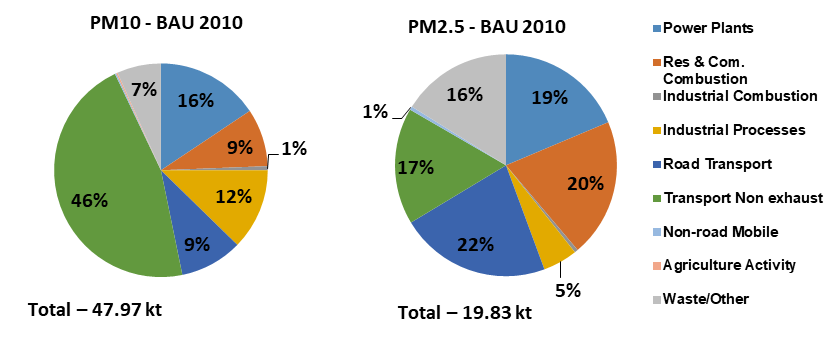Executive Summary
The Current levels of particulate matter (PM2.5) in India exceed the World Health Organization guideline of 10ug/m3 by more than a factor of four. In Delhi, about 40% of PM2.5 that the average inhabitant of Delhi is exposed to originates from within the city. Instead, the majority (60%) comes from surrounding states of Haryana and Uttar Pradesh, a quarter from sources even further away including neighboring regions, and a quarter from natural sources.
GAINS model is a scientific tool developed to explore cost-effective emission control strategies that simultaneously tackle local air quality and greenhouse gases (GHGs). GAINS estimates historic emissions of 10 air pollutants and 6 GHGs for each country/region based on data from international energy and industrial statistics, emission inventories and on data provided by countries themselves. It assesses emissions on a medium-term time horizon, with projections being specified in five-year intervals through the year 2050 under various scenarios. The 2010 emission inventory estimated from GAINS model for fine particulates PM10 and PM2.5 for Delhi city indicates that transport non exhaust (road dust) is major of PM10 while power plant, road transport and residential/commercial sector forms the major source of PM2.5.

Different planning/policies towards implementation for various sources are considered under various scenarios such as: Business as Usual (BAU), - based on current legislations, Advanced Control Technology (ACT), - based on better efficiency equipments, Maximum Technically Feasible Reduction (MFR) - based on better control for maximum achievable control, and Low Carbon or Clean Fuel Scenario (CFS) – by use of cleaner fuel/technology.
Experience throughout the world shows that short-term interventions during pollution episodes, like cutting traffic or halting industrial production, are among the economically most expensive ways of managing air quality. Alternative approaches that reduce overall emissions from the most important sources throughout the year are economically much more efficient.”
Action Points for Controlling Delhi Polution
For Delhi NCT, if one controls industrial processes and combustion sector in Delhi then cost of advanced control technologies is too high. Further the reduction from this sector is not significant. Therefore, the best solution is to go for non-conventional measures such as a) Ban of agricultural waste burning, b) Paved roads, c) Improved public transport, d) Improved energy efficiency, e), Natural gas for power and industry, f) Biomass cook stoves replaced by electricity/natural gas, g) electric/gas BBQs, h) Ban of trash burning, i), Fewer fireworks, etc.
However, it is difficult to estmmate the cost related information for ban on trash burning, pavement of roads, control on construction sites, ban on agricultural residue burning, etc. GAINS predicts cost of end of pipe technologies in power, industrial and residential commercial sectors.
Emission control costs for air pollutants
Air pollution control cost is estimated at 0.2 billion Euro in 2010. Cost of control measures in road vehicles contribute 93% of the total air pollution control costs followed by control measures power plants (6%) and non-road machinery (1%). In 2030, cost of control measures will increase by a factor of 1.9 in CAS and 2.1 in ACT scenarios and decrease by a factor of 0.97 in LCI scenario as compared to the BAU scenario. In CAS and ACT scenario, the increase is primarily due to Flue-gas desulfurization (FGD) in the power sector and advanced control in industrial processes and agriculture. Air pollution control cost in LCI scenario will decrease by 3-4% as a co-benefit of climate policies primarily due to switch towards cleaner fuels in the power plant sector.
Price Rs. 30,000

